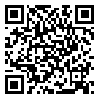جلد 14، شماره 3 - ( 6-1404 )
جلد 14 شماره 3 صفحات 14-7 |
برگشت به فهرست نسخه ها
Download citation:
BibTeX | RIS | EndNote | Medlars | ProCite | Reference Manager | RefWorks
Send citation to:



BibTeX | RIS | EndNote | Medlars | ProCite | Reference Manager | RefWorks
Send citation to:
Rostami A, Sharifipour Chokami H, Ostovarrad F, Javidi P, Tabari Khomeiran R. Examining the prevalence of soft palate morphology in individuals with cleft palate among patients referred to the dental schools of Guilan University of Medical Sciences during the years 2017-2019. Journal title 2025; 14 (3) :7-14
URL: http://3dj.gums.ac.ir/article-1-653-fa.html
URL: http://3dj.gums.ac.ir/article-1-653-fa.html
Examining the prevalence of soft palate morphology in individuals with cleft palate among patients referred to the dental schools of Guilan University of Medical Sciences during the years 2017-2019. عنوان نشریه. 1404; 14 (3) :7-14
چکیده: (108 مشاهده)
Introduction: The soft palate, a fibromuscular structure extending from the posterior edge of the hard palate, exhibits dysfunction in conditions such as cleft palate. Understanding its diverse morphologies across pathological conditions is critical for precise diagnosis and treatment. This study aimed to assess the prevalence of distinct soft palate morphologies in individuals with cleft palate.
Materials & Methods: This cross-sectional descriptive study involved patients with cleft palate referred to the School of Dentistry at Guilan University of Medical Sciences. Lateral cephalometric radiographs were reviewed, starting from the most recent, until the required sample size was achieved. Only one radiograph per patient was analyzed, excluding duplicates. Images were captured using a Sordex panoramic device (Helsinki, Finland) in proper positioning and exposure. Radiographs were manually analyzed on a negatoscope with tracing paper utilizing the YOU classification system.
Results: The results indicate that the Leaf-shaped type had the highest frequency, with 36 cases (40%), while the Straight line and S-shaped types both had the lowest frequency, each with 5 cases (5.6%). Moreover, there was no significant relationship between gender and morphology type (p = 0.86) found. Also, the findings indicated no significant association between age group and morphology type(p = 0.254).
Conclusion: The results revealed that the Leaf shaped type had the highest frequency, while the Straight line and S shaped types had the lowest frequencies. No significant correlation was found between gender or age and the type of morphology. In both genders, the Leaf shaped type was the most prevalent morphological type.
Materials & Methods: This cross-sectional descriptive study involved patients with cleft palate referred to the School of Dentistry at Guilan University of Medical Sciences. Lateral cephalometric radiographs were reviewed, starting from the most recent, until the required sample size was achieved. Only one radiograph per patient was analyzed, excluding duplicates. Images were captured using a Sordex panoramic device (Helsinki, Finland) in proper positioning and exposure. Radiographs were manually analyzed on a negatoscope with tracing paper utilizing the YOU classification system.
Results: The results indicate that the Leaf-shaped type had the highest frequency, with 36 cases (40%), while the Straight line and S-shaped types both had the lowest frequency, each with 5 cases (5.6%). Moreover, there was no significant relationship between gender and morphology type (p = 0.86) found. Also, the findings indicated no significant association between age group and morphology type(p = 0.254).
Conclusion: The results revealed that the Leaf shaped type had the highest frequency, while the Straight line and S shaped types had the lowest frequencies. No significant correlation was found between gender or age and the type of morphology. In both genders, the Leaf shaped type was the most prevalent morphological type.
| بازنشر اطلاعات | |
 | این مقاله تحت شرایط Creative Commons Attribution-NonCommercial 4.0 International License قابل بازنشر است. |

